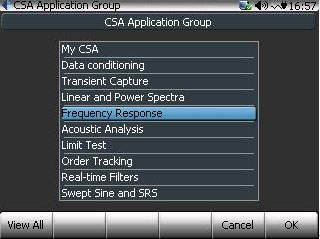- 基本运算:FFT
FFT是频谱分析的基础,以下的四种分析功能均以FFT变换的结果为基础,再进行二次处理得到。
FFT变换的结果为复数,含有原始信号的相位信息。
注:测试周期稳态振动信号RMS的用户请注意:请选择自功率谱进行测试,FFT功能要求相位对齐,如果在相位不对齐的情况下,测得的数值并不准确。
- 自功率谱:auto power spectrum,Gxx
自功率谱直接从FFT变换的结果求出,
自功率谱不带相位信息,因此不要求相位对齐。
1.9.5以后版本的APS带声学记权功能
此功能多用于振动信号的能量或rms测试。
计算过程:
To compute the spectra listed above, follow these steps:
Step 1
A window is applied:
x(k) = w(k) x(k)’
where x(k)’ is the original data and x(k) is the data used for a Fourier transform.
Step 2
The FFT is applied to x(t) to compute Sx
Now, periodogram method is used to compute the spectra with area correction
Step 3.1
Power Spectrum Sxx = Sx Sx* / (LineCorr)2
Step 3.2
Power Spectral Density = Sx Sx* T / AreaCorr
Step 3.3
Energy Spectral Density = Sx Sx* T2 / AreaCorr
Step 3.4
RMS Spectrum =
where T is the time duration of the capture. The symbol * is for complex conjugation. AreaCorr is a factor for area correction, which is defined as:
N is the total number of the samples and w(k) is window function.
- 互功率谱:cross power spectrum,Gxy
互功率谱需要由两个输入通道:激励通道和响应通道,默认第一通道为激励通道。
计算过程:
To compute the cross-power spectral density Gxy between channel x and channel y:
Step 1, compute the Fourier transform
Step 2, compute the instantaneous cross power spectral density
Sxy = Sx* Sy T
Step 2, average the M frames of Sxx to get averaged PSD Gxx
Gxy’ = Average (Sxy)
Step 3, Do area correction and double the value for single-sided spectra
Gxy = 2 Gxy’ / AreaCorr
- 传递函数(transfer function):FRF,Hxy
传递函数需要由两个输入通道:激励通道和响应通道,默认第一通道为激励通道。此功能最多用于锤击试验。
传递函数(transfer function)的计算实质是响应通道与激励通道的互功率谱比上激励通道的自功率谱得到:
The cross power spectrum method is used for estimating the transfer function between channel x and channel y. The equation is:
where Gxy is the averaged cross-spectrum between the input channel x and output channel y. Gxx is the averaged auto-spectrum of the input. Either power spectrum, power spectral density or energy spectral density can be used here because of the linear relationship between input and output.
This approach will reduce the effect of the noise at the output measurement end, as shown below.
The transfer function has a complex data format. Your can view it in real, imaginary, magnitude or phase display format.
- 相关系数: coherence,Coh(x,y)
传递函数谱需要由两个输入通道:激励通道和响应通道,默认第一通道为激励通道。
The coherence function is defined as:
where Gxy is the averaged cross-spectrum between the input channel x and output channel y. Gxx and Gyy are the averaged auto-spectrum of the input and output. Either power spectrum, power spectral density or energy spectral density can be used here because of the linear relationship between input and output.
When the averaging number is 1, coherence function has a meaningless result of 1.0 due to the estimation error of the coherence function.
The coherence function is a non-dimensional real function in the frequency domain. You can only view it in the real format.
Note: When describing a system with input x and output y as shown above, some people are used to a notation Hyx instead of Hxy. The most Most DSA products follow the convention used in the reference books listed before. Hxy stands for a transfer function with input x and output y.






